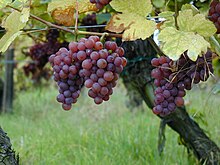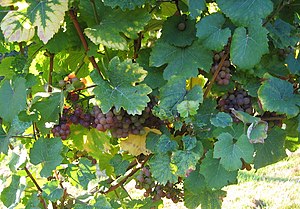| Traminer | |
|---|---|
| Grape (Vitis) | |
 Gewürztraminer vine and grapes | |
| Species | Vitis vinifera |
| Also called | Savagnin, Gewürztraminer |
| Notable regions | Alsace, Germany, Austria, NE Italy |

Traminer is a family of white grape varieties used in wine production, with the highly aromatic Gewürztraminer being the most well known and by far the most cultivated today.[1][2][3] Traminer is an ancient cultivar of the European vine Vitis vinifera and a large number of other younger grape varieties have Traminer in their pedigree.
The name Traminer is derived from the village of Tramin in South Tyrol, today part of Italy, where the original Traminer variety may have spread from. Modern-day Gewürztraminer, on the other hand, most likely developed much later in Germany by mutation.
Classification and members of the Traminer family
editThe Traminer family encompasses several varieties and a large number of clones, that are known under several overlapping synonyms in different wine-producing regions. Therefore, the distinction between different varieties and merely clones of the same variety under a local name is somewhat blurred. Despite these difficulties, the members of Traminer family are often grouped into three distinct varieties based on difference in the colour of their grape skins and the level of fragrance (musqué) of the grapes. These three varieties, and some of their proper names are:[3]
| Less aromatic non-musqué |
Highly aromatic musqué | |
|---|---|---|
| Pale grape skins (yellow) |
White Traminer (Weisser Traminer) Yellow Traminer (Gelber Traminer) Savagnin Blanc |
Not a known combination |
| Highly coloured grape skins (red-brown, red, pink or orange) |
Red Traminer (Roter Traminer) Savagnin Rose |
Gewürztraminer |
The division into three varieties used above mainly goes back to the French ampelographer Pierre Galet, who put forward the hypothesis that Savagnin and Traminer are in fact the same variety.
Genetic relationship between the members
editThere are various differences in leaf morphology, vine size and grape yield between members of the family. Genetically, the three varieties are similar enough to be undistinguishable from each other by the methods most commonly used since the 1990s for DNA-based ampelographic investigations. Such investigations have mainly been directed at indentifying the parentage of grape varieties resulting from crossings of two varieties, i.e., where one variety has pollinated another and the original vine of the new variety was grown from a seed, a so-called seedling. This indicates that the difference between the members of the Traminer family stems from mutations, and not from crossings.
Musqué mutations are known for several varieties, and therefore Gewürztraminer is a mutation of Red Traminer. It is not entirely certain if Red Traminer or White Traminer is the original Traminer grape, since mutatations are known to be able to change grape skins both from pale to gris and the other way around. However, the case for White Traminer being older is strong, since it exists in a large number of clones, which is usually a sign of a long history of cultivation.
Naming confusion
editPart of the naming confusion derives from the fact that part of German-speaking wine community previously only differentiated the members of the Traminer family by grape skin colour. Thus, the less aromatic Red Traminer was seen as the same grape variety as the highly aromatic Gewürztraminer. (The Vitis International Variety Catalogue, based in Germany, still treats Roter Traminer and Gewürztraminer as the same variety, under the name of the former,[4] and so does the official German statistics on plantations of varities.) Furthermore, the distinction between White/Yellow Traminer and Red Traminer, while obvious in the vineyard at harvest time, was not always displayed on wine labels, leading to Traminer being used as a synonym for any variety in the family. More rarely, the reciprocal name use has been applied, with Gewürztraminer being used as a synonym for any Traminer variety, but probably more in descriptive text than on wine labels.
Gewürztraminer
editThe highly aromatic Gewürztraminer is one of the most easily distinguishable grape varieties. It is by far the most popular member of the family, and accounts for the bulk of all plantations of Traminer family grapes.[2]
It is generally considered a musqué mutation of the less aromatic Red Traminer. Thus, Gewürztraminer is younger than Red Traminer, but is not known when the mutation took place.
White Traminer or Savagnin Blanc
editThe pale-skinned Traminer grape is known in France as Savagnin Blanc, and is primaril grown for use in Jura wine. Savagnin Blanc is used both for highly distinctive Vin jaune and for other dry white wines, and for sweet Vin de paille.
It seems likely that a white Traminer is the oldest member of the family, since there are apparently more clones of white Traminer than of red Traminer. More clones indicates that it has been propagated by cuttings for a longer time, with more chance for mutations producing slightly different versions.
Red Traminer or Savagnin Rose
editThe red-skinned, but less aromatic Traminer grape is known in France as Savagnin Rose, and is to some extent grown in Alsace to make the wine Klevener de Heiligenstein. However, plantings are dwarfed by those of Alsatian Gewürztraminer, and replanting is not allowed.
The designation red does not mean that it is a dark-skinned "red wine" grape (which are generally described as blue in German and black in French), only that the grapes are literally red or reddish, i.e., more deeply coloured than the white or yellow Traminer.
History
editNext to the Muscat family of grapes, the Traminer family probably contain the most ancient grape varieties still in cultivation. The exact age or geographic origin has not been established, but many hypotheses have been forwarded, and it is likely that the history of Traminer cultivation goes back at least to antiquity.[3]
Proposed origins include ancient Egypt, Greece (coupled with a later introduction in Italy) or South Tyrol. German ampelographer Hermann Goethe proposed that Traminer was identical to the variety Aminea described by Pliny the Elder in the first century B.C., while others have assumed that Traminer would be Pliny's Nomentana. There seems to be little ampelographic evidence to back up any of these hypotheses.[3]
Modern ampelographic investigations based on DNA sequencing do however support earlier assumptions that the Traminer family is very old, by establishing the following:[3]
- Traminer appears in the pedigree of a large number of other varieties, several of which have been well documented back to the 14th century (Pinot Noir as Klebroth on Lake Constance, 1318[5]), and some of which are sometimes assumed to date back to antiquity (such as Elbling).
- No other grape variety that has been analysed appears to be a parent of Traminer.
- There are indications, from investigations in the 1990s, that Traminer was selected from wild vines, Vitis vinifera ssp. sylvestris. However, such conclusions are not entirely certain, since the limited population of sexually propagating wild vine that exists today may have had genetic material from cultivated vines (non-sexually propagated by man) mixed in, rather than being "untainted".
In the 1546 edition of his herbal Kreütter Buch, Hieronymus Bock used the name "Traminner".[3]
The name Traminer most likely refers to the village Tramin (Italian name Termeno) in South Tyrol, with the suffix "-er" being the German language possessive form. Trade with Traminer in the meaning "wine of Tramin" have been documented back to medieval times, but is thought likely that those wines were produced from the variety Räuschling, which is also called Großer Traminer.[3] For ancient grapes like Traminer, the origin of the modern name does not automatically indicate the variety's origin. For varieties selected from wild wines, very little clues as to the geographic origin is provided by DNA analysis. Thus, the origin and early history of Traminer is not known, only that it has a long history.
The Gewürz- part of Gewürztraminer has been added later, possibly in the Palatinate in Germany. The name Gewürztraminer started to be used in Alsace after 1870. For a long time, Gewürztraminer would be used as a designation for better wines, with simpler ones called Traminer, but in 1973 Gewürztraminer was adopted as the only allowed name.
Traminer offspring
editGrape varities that are the offspring of Traminer include:[3]
- Elbling - Weisser Heunisch x (Traminer x unknown Partner)
- Pinot Noir - unknown x Traminer
- ...which appears in the pedigree of a large number of grapes, such as Pinot Gris, Pinot Blanc, Pinot Meunier and Chardonnay
- Rotgipfler - Traminer x Roter Veltliner
- Silvaner - Traminer x Österreichisch-Weiß (= Heunisch x unknown)
- Grüner Veltliner - (probably Roter Veltliner x unknown) x Traminer
- Fütterer - Heunisch x Traminer
- Riesling - Heunisch x (Traminer x unknown?)
References
edit- ^ Jancis Robinson, ed. (2006). "Traminer". Oxford Companion to Wine (Third Edition ed.). Oxford: Oxford University Press. pp. 708–709. ISBN 0-19-860990-6.
{{cite encyclopedia}}:|edition=has extra text (help) - ^ a b Jancis Robinson, ed. (2006). "Gewürztraminer". Oxford Companion to Wine (Third Edition ed.). Oxford: Oxford University Press. pp. 313–314. ISBN 0-19-860990-6.
{{cite encyclopedia}}:|edition=has extra text (help) - ^ a b c d e f g h Wein-Plus Wein-Glossar: Traminer, accessed on April 8, 2008
- ^ Vitis International Variety Catalogue: Roter Traminer, accessed on April 23, 2008]
- ^ Wein-Plus Wein-Glossar: Pinot Noir, accessed on April 8, 2008
[[Category:Grape varieties]]